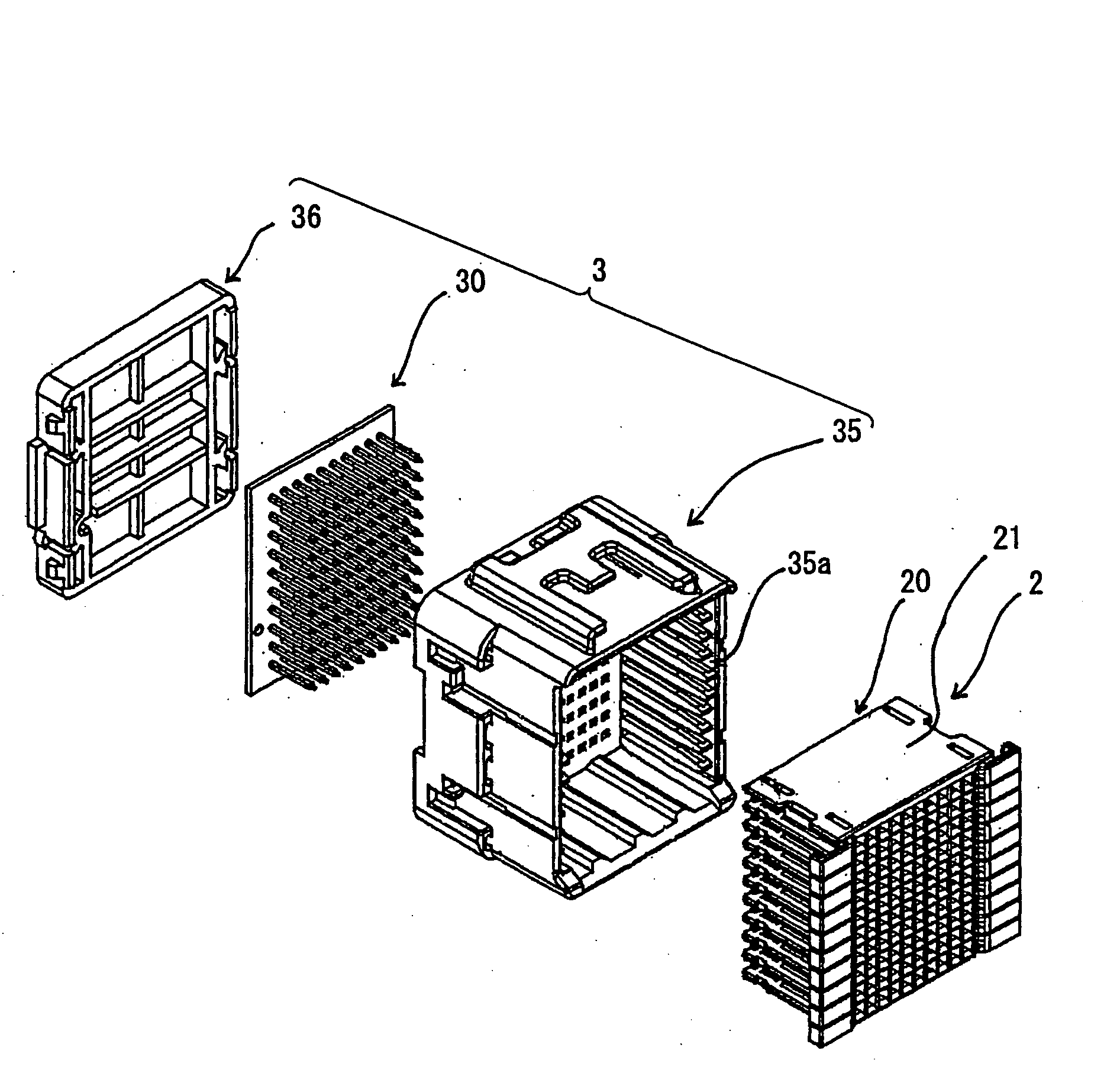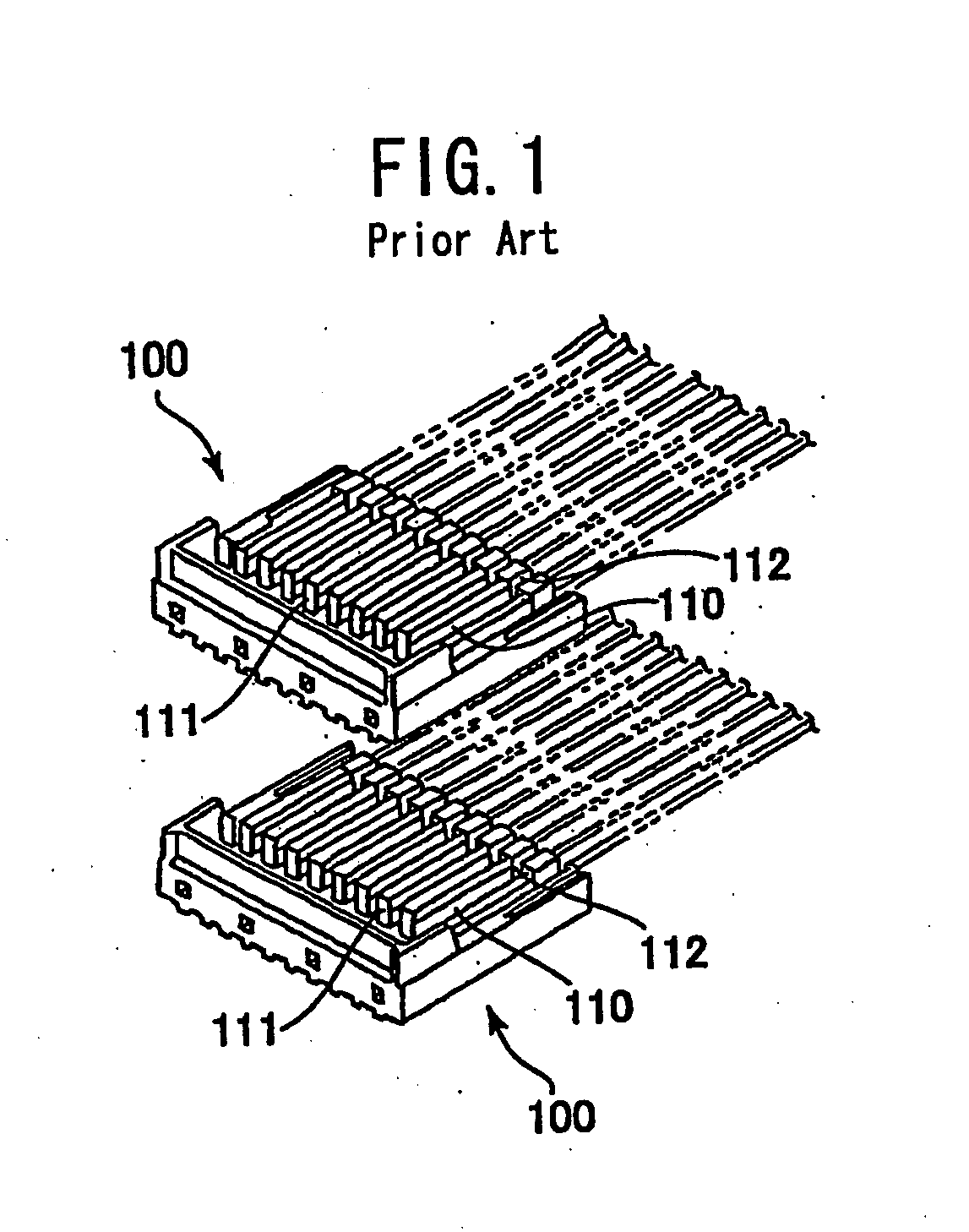Joint connector
a technology of joint connectors and connectors, which is applied in the direction of vehicle connectors, coupling device connections, electrical apparatus, etc., can solve the problems of reducing the efficiency of electric wire connecting operation by the joint connector, increasing the size of the joint connector itself, and the size of the terminal itself becomes large to a certain extent, so as to detect the upside-down insertion of the connecting terminal into the terminal-accommodating compartment quickly
- Summary
- Abstract
- Description
- Claims
- Application Information
AI Technical Summary
Benefits of technology
Problems solved by technology
Method used
Image
Examples
first embodiment
[0153] As shown in the exploded perspective view of FIG. 8 and the assembled view of FIG. 9, a joint connector 1 according to the present invention is provided with a female connector 2 having a large number of female terminals F, and a housing 35 in which the female connector 2 can be accommodated. It is also provided with a large number of male terminals M (see FIG. 11) for connecting the female terminals F (see FIG. 10) of the female connector 2, and a male connector 3 having a cover 36 attached on a side opposite to the side of the housing 35 into which the female connector is inserted.
[0154] As shown FIG. 10, the female connector 2 has a structure in which female connector elements 20, comprising a rectangular thick-plate-like female terminal holder (one-stage parallel-line-shaped connector housing) 21 and female terminals F juxtaposed in the female terminal holder 21, are stacked in a vertical direction. The female connector elements 20 correspond to each one of sub-harnesses,...
second embodiment
[0182] Now, a joint connector according to the present invention is described in detail with reference to the drawings.
[0183]FIG. 14 is an exploded perspective view showing a joint connector according to the second embodiment of the present invention, adapted to a multi-pin connector for automobile wire harnesses. FIG. 15 is an enlarged perspective view showing the joint connector in an assembled condition, in which the component parts of FIG. 14 are combined. FIG. 16 shows a connector housing constituting an inserting-side connector portion of FIG. 14, in which FIG. 16A is a perspective view thereof, viewed from its obverse side and FIG. 16B is a perspective view thereof, viewed from its reverse side. FIG. 17 shows a connector housing of FIG. 16, in which FIG. 17A is a top plan view thereof, and FIG. 17B is a bottom plan view thereof.
[0184] A joint connector according to the second embodiment of the present invention comprises, as shown in the above-mentioned figures, an inserting...
third embodiment
[0234] The joint connector according to the present invention is assembles as follows. In the terminal-accommodating compartments 619 of the connector housings 617, the female terminals connected to the terminals of the electric wires constituting a wire harness are accommodated, and the connector housings 617 are stacked, and are combined by the connector-coupling means 625, to obtain the inserting-side connector portion 611. Next, this inserting-side connector portion 611 is opposed to the receiving-side connector portion 613, the centers (axes) of both connector portions 611 and 613 are aligned, and the inserting-side connector portion 611 is inserted into the first accommodating space 633 of the connector case 621 in the receiving-side connector portion 613. Then, the claws 647 of the engaging claw portions 645 of the connector-locking means 615 are engaged with the engagement recess portions 643 to lock both connector portions 611 and 613, and the male terminals 623 of the rece...
PUM
 Login to View More
Login to View More Abstract
Description
Claims
Application Information
 Login to View More
Login to View More - R&D
- Intellectual Property
- Life Sciences
- Materials
- Tech Scout
- Unparalleled Data Quality
- Higher Quality Content
- 60% Fewer Hallucinations
Browse by: Latest US Patents, China's latest patents, Technical Efficacy Thesaurus, Application Domain, Technology Topic, Popular Technical Reports.
© 2025 PatSnap. All rights reserved.Legal|Privacy policy|Modern Slavery Act Transparency Statement|Sitemap|About US| Contact US: help@patsnap.com



